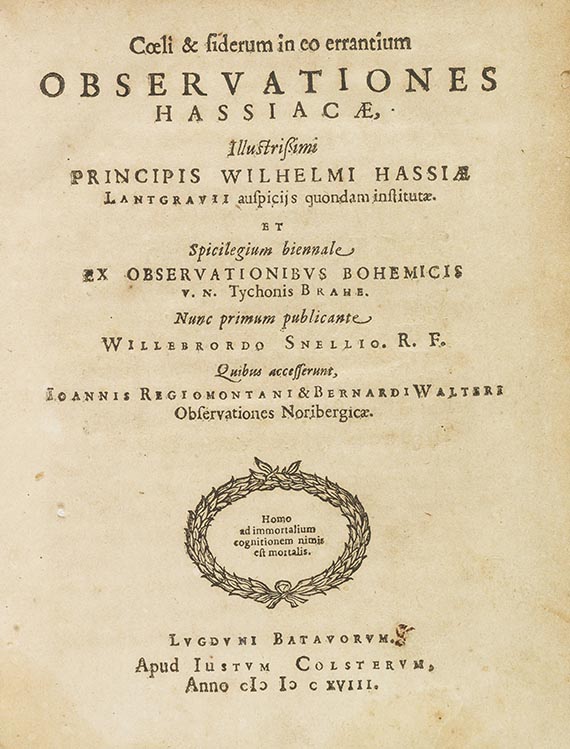BRAHE, Tycho (1546-1601). Tychonis Brahe, Dani De nova et nullius aevi memoria prius visa stella, iam pridem anno a' nato Christo 1572, mense Novembri primum conspecta, contemplatio mathematica: cui, praeter exactam Eclipsis lunaris, huius anni, pragmatian, et elegantem In Vraniam elegiam, Epistola quoq[ue] Dedicatoria accessit: in qua, nova & erudita conscribendi diaria metheorologica methodus, utriusq[ue] astrologiae studiosis, eodem autore, proponitur ... Copenhagen: Laurentius Benedictus, 1573. First edition of one of the rarest and most important pamphlets in the history of science: Tycho Brahe’s discovery of a new star, the emphatic first-ever use of the term ‘nova’ in relation to a star, and the incontrovertible refutation of the Aristotelian model of an unchanging celestial realm. The De nova…stella is ‘Tycho Brahe's earliest work. By his discovery and proof of the existence of a new star in outer space, the assumptions of the infallibility of the ancients and of the immutability of the heavens were upset’ (Horblit). Tycho’s remarkably precise measurements showed that ‘new stars’, specifically that of 1572, did not present the parallax expected in sublunar phenomena, and so could not simply be comets within the atmosphere as previously thought: they had to be placed above the atmosphere and beyond the moon. Comets also, he concluded, must pass through the supposedly immutable celestial spheres. The central parts of this work were later reprinted in Tycho’s larger work, Astronomiae Instauratae Progymnasmata (1602). Only 2 copies have been recorded at auction since the 1930s, the last record having been that of the Honeyman collection (pt 1, 486) which lacked 6 leaves and had a defective title. See J.L.E. Dreyer, Tycho Brahe , 1963, p. 44-57. Grolier 16; Houzeau & Lancaster 2698 (‘excessivement rare. L’edition a été detruite presque entièrement’). Quarto (190 x 142mm). 6 large woodcut astronomical diagrams in the text (lacking 2 preliminary leaves containing Johannes Pratensis’ address to Brahe, f. (:)4 misbound just before A1, title and f. (:)4 reinforced at gutter and with small paper repairs to the upper margin and lower outer corner, a few minute holes touching a couple of letters and some soiling to the title, some unobtrusive waterstaining to the outer margin throughout). Bound with : D. Chytraeus, De Stella inusitata et nova, quae 1572 conspici coepit et de Comato Sidere, quod hoc Mense Novembri Anno 1577 videmus , Rostock, 1577. Ff. 10 (of 12), lacking C1 and C4: first and only edition of a report on comet sighting by a Rostock theologian; no copies located in the UK or US. Late 19th-century library cloth-backed boards, paper label on the spine (a little rubbed). Provenance : Rostock University (19th-century stamp on the title and on title verso of second work) – ‘F. Reppien’ (early 20th-century small typed paper label on rear pastedown).
BRAHE, Tycho (1546-1601). Tychonis Brahe, Dani De nova et nullius aevi memoria prius visa stella, iam pridem anno a' nato Christo 1572, mense Novembri primum conspecta, contemplatio mathematica: cui, praeter exactam Eclipsis lunaris, huius anni, pragmatian, et elegantem In Vraniam elegiam, Epistola quoq[ue] Dedicatoria accessit: in qua, nova & erudita conscribendi diaria metheorologica methodus, utriusq[ue] astrologiae studiosis, eodem autore, proponitur ... Copenhagen: Laurentius Benedictus, 1573. First edition of one of the rarest and most important pamphlets in the history of science: Tycho Brahe’s discovery of a new star, the emphatic first-ever use of the term ‘nova’ in relation to a star, and the incontrovertible refutation of the Aristotelian model of an unchanging celestial realm. The De nova…stella is ‘Tycho Brahe's earliest work. By his discovery and proof of the existence of a new star in outer space, the assumptions of the infallibility of the ancients and of the immutability of the heavens were upset’ (Horblit). Tycho’s remarkably precise measurements showed that ‘new stars’, specifically that of 1572, did not present the parallax expected in sublunar phenomena, and so could not simply be comets within the atmosphere as previously thought: they had to be placed above the atmosphere and beyond the moon. Comets also, he concluded, must pass through the supposedly immutable celestial spheres. The central parts of this work were later reprinted in Tycho’s larger work, Astronomiae Instauratae Progymnasmata (1602). Only 2 copies have been recorded at auction since the 1930s, the last record having been that of the Honeyman collection (pt 1, 486) which lacked 6 leaves and had a defective title. See J.L.E. Dreyer, Tycho Brahe , 1963, p. 44-57. Grolier 16; Houzeau & Lancaster 2698 (‘excessivement rare. L’edition a été detruite presque entièrement’). Quarto (190 x 142mm). 6 large woodcut astronomical diagrams in the text (lacking 2 preliminary leaves containing Johannes Pratensis’ address to Brahe, f. (:)4 misbound just before A1, title and f. (:)4 reinforced at gutter and with small paper repairs to the upper margin and lower outer corner, a few minute holes touching a couple of letters and some soiling to the title, some unobtrusive waterstaining to the outer margin throughout). Bound with : D. Chytraeus, De Stella inusitata et nova, quae 1572 conspici coepit et de Comato Sidere, quod hoc Mense Novembri Anno 1577 videmus , Rostock, 1577. Ff. 10 (of 12), lacking C1 and C4: first and only edition of a report on comet sighting by a Rostock theologian; no copies located in the UK or US. Late 19th-century library cloth-backed boards, paper label on the spine (a little rubbed). Provenance : Rostock University (19th-century stamp on the title and on title verso of second work) – ‘F. Reppien’ (early 20th-century small typed paper label on rear pastedown).












.jpg)
.jpg)
Testen Sie LotSearch und seine Premium-Features 7 Tage - ohne Kosten!
Lassen Sie sich automatisch über neue Objekte in kommenden Auktionen benachrichtigen.
Suchauftrag anlegen